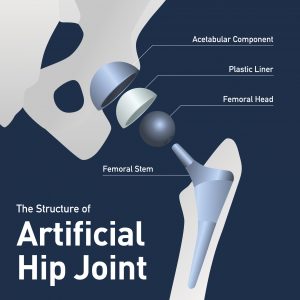 For a while now, Stryker has had issues with some of its hip replacement artificial implants. One troublesome type in particular has been the LFIT V40 series. Specifically, in some of these Stryker hips corrosion forms where the femoral head connects with the femoral stem. This would often lead to taper lock failure, or a compromised joint that would loosen and cause metallosis.
For a while now, Stryker has had issues with some of its hip replacement artificial implants. One troublesome type in particular has been the LFIT V40 series. Specifically, in some of these Stryker hips corrosion forms where the femoral head connects with the femoral stem. This would often lead to taper lock failure, or a compromised joint that would loosen and cause metallosis.
This issue helped lead to a recall in 2016 and an expanded recall in 2018. One of the reasons for the 2018 recall was a higher-than-expected number of reports of the femoral head disassociating (disconnecting) from the femoral stem.
What Is Artificial Hip Disassociation?
 Also referred to as “dissociation,” disassociation describes situations where the femoral head (the round, ball-like part of the hip implant) actually breaks away from the stem of the hip implant. The image at right helps illustrate what these parts do and roughly where the dissociation would occur.
Also referred to as “dissociation,” disassociation describes situations where the femoral head (the round, ball-like part of the hip implant) actually breaks away from the stem of the hip implant. The image at right helps illustrate what these parts do and roughly where the dissociation would occur.
What Causes the Stryker LFIT V40 Dissociation Failures?
The main reason for dissociation in LFIT V40 artificial hips is corrosion where the femoral head joins the femoral stem. This usually starts slow and goes unnoticed by the patient for many months and even years. Over time, the corrosion gets worse and likely causes metallosis. Once enough time passes, the corrosion gets so bad that the head and stem joint break apart or disconnect leading to a catastrophic failure of the hip implant.
What Causes the Corrosion?
The corrosion could be caused by excessive friction between the metal components. Ideally, when the femoral head is attached to the femoral stem, it is a perfect joint, with no movement between the two parts. Unfortunately, the Stryker LFIT V40 components often wouldn’t be properly connected. This could lead to micromotion, or a very small amount of “wiggling” between the parts. Too much movement or grinding can cause the neck to grind down (sometimes referred to as “penciling”), where the neck grinds away to a sharpened point, like a pencil. Ultimately, this could result in corrosive wear and create a dissociation failure.
How Can I Tell if My Hip Replacement Has Disassociated?
If your artificial hip implant disassociates, you’ll most likely know something is very wrong with your hip. You will likely endure one or more of the following symptoms:
- Pain and/or inflammation (the pain is often significant).
- Joint instability.
- Metallosis.
- Reduced mobility (even inability to walk).
- One leg becoming longer or shorter.
- Broken bones in areas surrounding the joint.
What Do I Need to Do If My Stryker Hip Implant Disassociates?
You’ll almost certainly need hip revision surgery (most likely, immediately). Because the corrosion leading to dissociation will be severe, this surgery will likely be extensive, requiring not just the femoral head to be replaced, but also the femoral stem. The removal of the femoral stem is a big deal because it will probably be very well-established in your femoral bone. The femoral stem can be removed, but it won’t be a pleasant experience.
I’m Feeling Fine Right Now, So Now What?
The first thing you can do is talk to your doctor to confirm if you received the affected Stryker LFIT V40 hip components. If you did, you’ll need to discuss the medical benefits of removing the V40 femoral head. If you’re lucky, only the head will need to be replaced and the femoral stem can be left alone. While this still requires revision surgery, it’s a far less complex or involved procedure. As always, rely on the advice of a trusted orthopedic surgeon for these medical decisions.
To learn more about potential issues with your Stryker LFIT V40 hip implant and what legal options you may have available, you can contact my office or call me at 919.334.6277
 North Carolina Product Liability Lawyer Blog
North Carolina Product Liability Lawyer Blog

